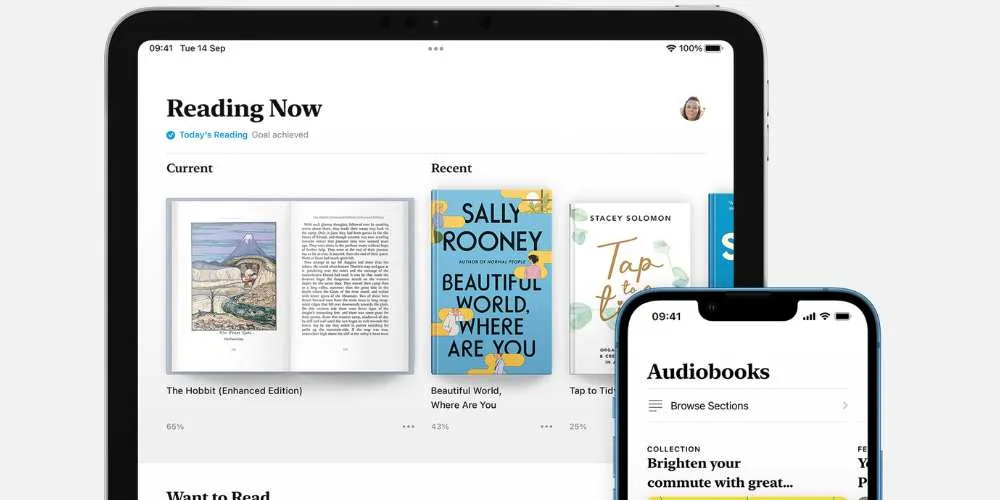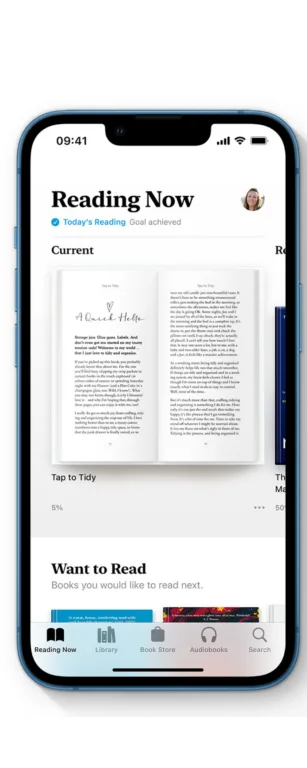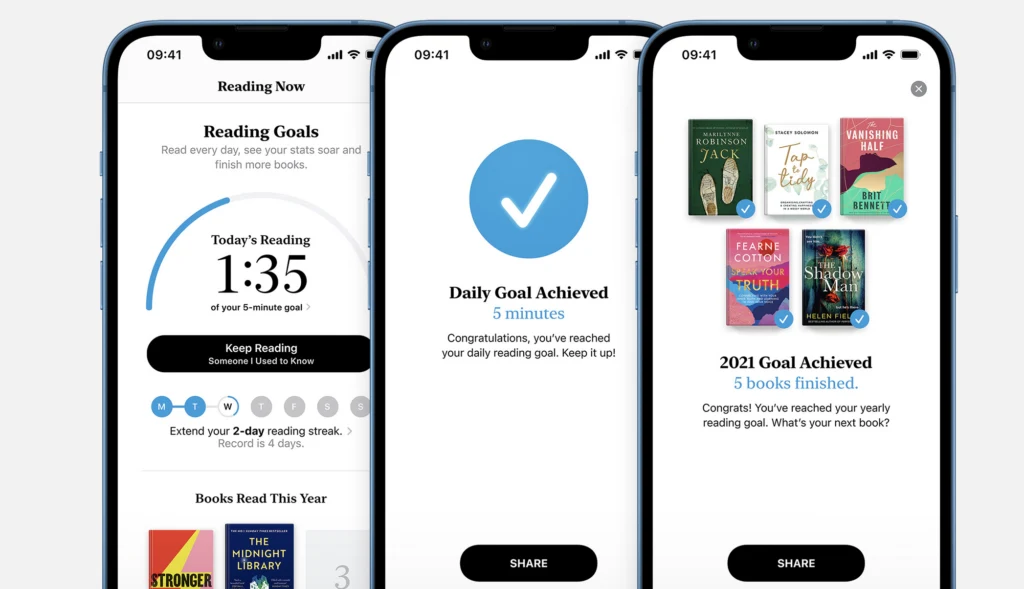When I first started exploring the world of digital reading, I couldn’t help but compare the major players in the market. Apple Books caught my attention as a unique and significant contender in the digital reading space.
As an avid Apple user, I appreciate the seamless integration Apple Books offers with my devices, making it easy for me to read on the go.
What sets Apple Books apart from its rivals, such as Kindle, is the clean and reliable user experience it provides across all Apple devices 9to5mac. It’s like having a one-stop shop for all my reading needs without having to rely on other subscriptions, apps, or hardware.
The fact that Apple designs its hardware and software in-house, and contracts manufacturer’s Knowledge at Wharton, sets them apart in terms of the elegant integration, design, and feel of their products.
As I dived further into the world of Apple Books, I realized that while there might be some apparent limitations in its library compared to Kindle’s store, there is still a vast collection of compelling titles waiting for me to explore Good e-Reader.
In the end, my reading experience with Apple Books has been more than satisfying, leaving me excited to see what’s in store for the future of digital reading with Apple.
Apple Books Overview
Brief History
As an avid reader, I remember when Apple Books first made its debut. Initially known as iBooks, it was introduced by Steve Jobs in 2010 as part of the iOS 4 update. From then on, it became a built-in app for iPhone and iPad users, allowing them to access a vast library of books and audiobooks.
Features
Over the years, Apple Books has been continuously innovating, expanding its offerings beyond just books and audiobooks. Some key features that make it stand out from its rivals include:
- Collections: Apple Books automatically organizes my library into several collections, so it’s easy for me to find and manage my books. I can also add custom collections to suit my preferences.
- PDF Support: Not only can I store books and audiobooks, but I can also save PDF files within the app. This makes it incredibly convenient to have all my reading materials in one place.
- iCloud Sync: As an Apple user, the seamless integration with other Apple devices made through iCloud is a game changer. This feature ensures that my library and reading progress are synchronised across all my devices.
Interface
One aspect of Apple Books that I appreciate is its clean and user-friendly interface. While it may not be the most advanced app compared to some competitors, it delivers a smooth and enjoyable reading experience. Here are some aspects of the interface that I find particularly useful:
- Customization: Apple Books offers various customization options, such as changing font size, adjusting brightness, and switching between day and night-time reading modes. This helps me tailor my reading experience to my preferences.
- Notes and Highlights: I can easily take notes or add highlights to my books, and then access them conveniently whenever I want.
- Reading Progress Indicator: The app displays my reading progress at the bottom of the screen, so I can quickly check how far along I am in a book.
In summary, my experience with Apple Books has been positive overall. The app offers convenient features, seamless iCloud integration, and a user-friendly interface, making it the go-to choice for many Apple users like me.

Key Differentiators
Content Selection
In my exploration of Apple Books, I’ve noticed that they boast an extensive content selection, with offerings ranging from popular fiction to academic textbooks. Apple’s strong relationships with publishers and authors have enabled them to curate a diverse library, ensuring that there’s something for everyone. Furthermore, Apple Books benefits from its affiliation with the Apple brand, attracting exclusive content to its platform, unavailable on competitors’ platforms.
User Experience
As an Apple product, Apple Books is designed to provide a seamless user experience, with a clean and intuitive interface that embodies Apple’s signature sleek design. The app is fully integrated into the Apple ecosystem, allowing users to sync their reading history and preferences across their Apple devices – keeping their library synchronized and accessible, no matter what device they choose to use.
Apple is known for its focus on technology and innovation, which is evident in Apple Books’ feature-rich reading tools. Users have access to:
- Customizable reading options, such as font, background color, and text size
- A built-in dictionary for quick word definitions
- Highlight and annotation functions for notetaking while reading
- Night mode for comfortable night-time reading
Pricing and Subscription Models
Apple Books offers competitive pricing and various purchasing options, including individual book sales and subscriptions, catering to the different preferences of their audience. They also feature a dedicated section for free books, allowing users to explore new titles without any financial commitment.
Although Apple Books does not have a bundled unlimited-access subscription model, like some competitors, they do integrate well with subscriptions offered by other entertainment companies present within the larger Apple ecosystem.
As a California-based company, Apple’s commitment to quality and secure technology also extends to Apple Books. They have built robust security measures into their app and payment systems to ensure that users’ personal and financial information remains protected.
Apple Books combines diverse content, an enjoyable reading experience, and flexible pricing models, setting the platform apart from its rivals.
Competitors Analysis
Amazon Kindle
In my analysis of Apple Books’ competitors, Amazon Kindle is undoubtedly one of the strongest rivals. Kindle dominates the e-book market with a vast library of titles and its own proprietary e-reader devices.
In contrast, Apple Books is accessible only on Apple devices, which may limit its reach to potential customers who are not already in the Apple ecosystem.
While both platforms offer a wide selection of titles, Amazon has the advantage of being a more established player in this space, which translates to better deals and exclusive content in some cases.
Google Play Books
Another significant competitor to Apple Books is Google Play Books, which is available across both Android and iOS devices. Being a part of the Google ecosystem, Play Books is tightly integrated with other Google services, making it a convenient choice for many users.
Additionally, it offers a vast collection of titles, including those from indie authors, giving it a competitive edge in terms of variety. In comparison, Apple Books tends to focus more on bestsellers and curated content.

Barnes & Noble Nook
Barnes & Noble Nook is a competitor that leverages its physical bookstore presence to strengthen its digital offerings. This allows them to offer exclusive deals and a wider range of categories, from popular fiction to academic resources.
However, Nook primarily operates within the US market, which means it may not pose as much of a threat to Apple Books on a global scale. That being said, their strong brand and loyal customer base are aspects that Apple Books need to consider when strategizing their market plans.
Kobo
Lastly, Kobo stands out as a competitor that offers a service similar to Apple Books, with both platforms providing the possibility to buy and read e-books from a wide selection of titles.
Kobo also offers its own e-reader devices, providing users with a dedicated reading experience. One thing that sets Kobo apart is its focus on supporting independent bookstores, which may appeal to a specific demographic of readers.
In comparison, Apple Books is deeply integrated into the Apple ecosystem, thereby benefiting from the brand loyalty and accessibility that comes with it.
In conclusion, Apple Books faces considerable competition from the likes of Amazon Kindle, Google Play Books, Barnes & Noble Nook, and Kobo.
Understanding the unique offerings and strengths of each competitor will be essential for Apple Books to stay ahead in the market and effectively cater to its target audience.
Market Share and Popularity
As an avid Apple user, I’ve noticed that one of the key selling points of Apple Books is its seamless integration with other Apple devices, such as the iPhone, iPad, and Apple Watch. This unparalleled compatibility allows Apple Books to maintain a competitive edge in the e-book market.
While Apple Books may not lead the market in terms of overall market share, it holds a strong presence among iPhone and iPad users.
The fact that it comes preloaded on all iOS devices, ensuring easy access for Apple customers, definitely contributes to its popularity. Additionally, with Apple’s user base being so consistent in their brand loyalty, it is not surprising that many opt for Apple’s e-book offering on their devices.
The user interface of Apple Books is designed to work in harmony with the overall Apple ecosystem, similar to how the iPod revolutionized the music industry.
With the continued growth of the iPhone and iPad sales, the demand for Apple Books is likely to follow suit.
Moreover, the iBooks Author platform helps reinforce Apple Books’ standing, allowing content creators to generate interactive and visually appealing eBooks, which can be easily shared with a wider audience. With Apple being well-known for prioritizing design, it is no wonder that Apple Books stands out in this regard.
To give you a better understanding of how Apple Books compares to its rivals, let’s take a closer look at some of its most notable features:
- Integration with Siri: Apple Books integrates smoothly with Siri, making it possible for users to ask Siri to read their books aloud on their iPhone, iPad, or Apple Watch.
- Curated Collections: Apple Books provides users with curated collections to help them discover new books and authors based on their interests and reading habits.
- Reading Goals: Users can set and track their reading goals, marking another distinguishing element for Apple Books.
In summary, my experience with Apple Books has highlighted its seamless integration with Apple devices, appealing design, innovative features, and strong presence among iOS users, as standout factors in distinguishing it from its rivals.
Apple Ecosystem Integration
iCloud
One major advantage of Apple Books over its rivals is the seamless integration with the Apple ecosystem, specifically iCloud. As an Apple user, you’re able to sync Apple Books with iCloud easily.
With this integration, I can quickly access my Apple Books library on all my devices, such as my iPhone, iPad, and MacBook.
iCloud also allows me to effortlessly sync bookmarks, notes, and reading progress across devices, making it convenient for me to pick up where I left off, regardless of the device I’m using.
Apple Pay
Another advantage of Apple Books is that I can use Apple Pay for making purchases within the app. Apple Pay provides a quick, secure, and easy method of payment, allowing me to buy books and audiobooks from the app without entering my credit card information every time.
This tight integration with Apple Pay not only improves the user experience but also makes transactions more secure.
Apple TV+
Apple Books is also integrated with Apple TV+, giving me access to exclusive content and interactive features like multimedia books.
For instance, I can find books that complement Apple TV+ shows and movies, adding another level of immersion to my entertainment experience. Plus, it encourages me to explore content that I might not have discovered otherwise.
App Store
Apple Books’ integration with the App Store offers me a unique advantage over its rivals. As part of the larger Apple ecosystem, the App Store offers additional apps that can enhance my reading experience.
For example, I can find apps that help me with notetaking, reading guides, or even language learning tools to help me read books in another language.
In summary, the integration of Apple Books with the Apple ecosystem sets it apart from its rivals. With seamless access to iCloud, secure transactions through Apple Pay, exclusive content via Apple TV+, and enhanced functionality from the App Store, Apple Books delivers a better reading experience to its users, making it a powerful contender in the technology industry and the smartphone market.
Pros and Cons of Apple Books
Advantages
As an Apple Books user, I appreciate the extensive library of eBooks and audiobooks in various languages that cater to readers across the globe. Apple Books is sold in more than 50 countries, which is quite an advantage when compared to Amazon.
One notable feature that I enjoy on Apple Books is the clean user interface that makes it easy to navigate and find what I’m looking for. Furthermore, the app is free to use and comes pre-installed on my Apple devices, allowing seamless integration with my iPhone, iPad, and Apple TV+ subscription.
Apple Books offers a variety of premium titles and exclusive releases, which makes the platform appealing to users who want high-quality content. Additionally, since Apple Books is designed specifically for Apple devices, I get the best reading experience on my smartphone or tablet.
Disadvantages
Despite its advantages, there are some drawbacks to using Apple Books. One significant downside is its exclusivity to Apple devices.
People who do not own an iPhone, iPad, or macOS device will not be able to access the Apple Books app, limiting its reach when compared to competitors like Amazon’s Kindle.
Furthermore, although Apple Books has an extensive library, some users have noted that it doesn’t feel as exhaustive or active as Amazon’s Kindle store. Users might find fewer free books and indie authors on Apple Books in comparison.
Lastly, the pricing of some books on Apple Books can be a deterrent for budget-conscious readers. While Apple Books does offer sales and promotions, it may not be the most cost-effective option for everyone.
In summary, Apple Books has several advantages, such as its extensive library, clean user interface, and integration with Apple devices.
However, it also has disadvantages like device exclusivity, possibly fewer free books, and potentially higher pricing for some titles.
Conclusion
In my experience using Apple Books, I found that it sets itself apart from its rivals through its seamless integration with the Apple ecosystem.
This integration is a result of how Apple runs its company, enabling users to enjoy a smooth reading experience on their Apple devices.
I also noticed that Apple Books has an aesthetically appealing user interface. This design choice makes it easy for me to navigate the store, browse for new books, and read my current library with ease. I appreciate the attention to detail that Apple has put into creating a visually pleasing experience for its users.
In terms of content, I feel that Apple Books has a wide variety of genres and authors to choose from, catering to different tastes and preferences.
While some may argue that other platforms provide more extensive libraries, I believe that Apple has curated a comprehensive and diverse selection for its users.
As for the pricing, I saw that Apple Books offers competitive prices when compared to its rivals. While some books may be pricier, I found that many others are similarly priced if not cheaper, making it an affordable choice for readers.
Lastly, the personalized recommendations in Apple Books have been beneficial in helping me discover new authors and titles. By analyzing my reading habits and preferences, Apple Books can offer relevant suggestions that are tailored to my interests.
In conclusion, Apple Books stands out from the competition through its seamless integration, attractive interface, diverse content, competitive pricing, and personalized recommendations.
These features have enhanced my overall reading experience, and as a result, I continue to choose Apple Books over its rivals.






